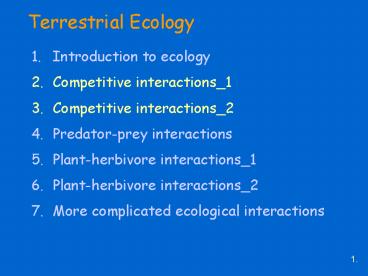Terrestrial Ecology - PowerPoint PPT Presentation
1 / 26
Title:
Terrestrial Ecology
Description:
in terms of the other 'How many ( ) hartebeest = 1 wildebeest ?' N2 = N1 individuals ' ... wildebeest & hartebeest population size. In 'wildebeest-equivalents' 19. ... – PowerPoint PPT presentation
Number of Views:33
Avg rating:3.0/5.0
Title: Terrestrial Ecology
1
Terrestrial Ecology
- Introduction to ecology
- Competitive interactions_1
- Competitive interactions_2
- Predator-prey interactions
- Plant-herbivore interactions_1
- Plant-herbivore interactions_2
- More complicated ecological interactions
2
Ecology
1. Studying interactions
2. Within between
3. At various levels
4. To understand (explain)
3
1st How do we define (classify) ecological
interactions?
4
Direct ecological interactions
- Defined by mechanisms
- Competition (- -)
- Predation ( -)
- Herbivory ( -, o?, ?)
- Parasitism ( -)
- Disease ( -)
- Mutualism ( )
- Others (? ?)
- Defined by effects
- - - Competition
- - Contramensalism
- Mutualism
- - o Amensalism
- o Commensalism
- o o No interaction
5
Direct ecological interactions
- Defined by mechanisms
- Competition (- -)
- Predation ( -)
- Herbivory ( -, o?, ?)
- Parasitism ( -)
- Disease ( -)
- Mutualism ( )
- Others (? ?)
- Defined by effects
- - - Competition
- - Contramensalism
- Mutualism
- - o Amensalism
- o Commensalism
- o o No interaction
- All interspecific
- Some intraspecific
- e.g. ??
Competition Mutualism Parasitism?
6
Interactions by mechanisms
- Competition (- -)
- Predation (? -?)
- Herbivory ( -, o?, ?)
- etc
- You know what youre studying
- predation is obvious!
- May not know effect until after studying it
- Focus what are the effects?
7
Interactions by effects on populations
- - - Competition
- - Contramensalism
- Mutualism
- etc
- Helps think clearly about outcome
- effect on population
- gt1 mechanism ? 1 effect
- mechanism not important
- Useful modelling communities
- But unknown until after studying system?
8
Which classification do you prefer?
- Depends on your questions
- I like defining by mechanismsChris likes
defining by effects - Why?
- Me how do these interactions work?
(details, often between individuals) - Chris what are the effects of the interactions
on communities?
9
back to Competition
- What is it?
- What types?
- Predicting outcomes of competition?
- How does it affect populations (ecology)?
- How can you detect it?
- How does it affect species (evolution)?
10
What is Competition?
- ? 2 species or individualseither (1) use the
same limited resourceor (2) seek the same
resourcewith detrimental effect on both
11
Types of competition?
- Resource competition
- Scramble or Exploitative competition
- Resource in common is limited
- Interference competition
- Context competition
- Resource in common not necessarily limited
- But individuals harm each other getting it
12
Predicting outcomes of competition?
Wildebeest hartebeest feeding on same resource
13
Modelling competitive outcomes
- If
- 2 species live together
- use the same resource(s)
- what happens to their populations?
- Mathematical models for predicting outcomes
include - Lotka Volterra (1925, 1926)NOT their
predator-prey models - Tilman (1977)
14
Lotka-Volterra Competition Model
- See Krebs 2001 for details
- Based on
- carrying capacity (K)
- Logistic growth curve
15
Lotka-Volterra Competition Model
Where for Species 1 N1 population size t
time r1 intrinsic capacity for ? K1 carrying
capacity
16
Lotka-Volterra Model Step 1
Step 1 describe population change for both
species
17
Lotka-Volterra Model Step 2
Step 2 describe one species in terms of the
other
How many (?) hartebeest 1 wildebeest ?
?N2 N1 individuals
How many (?) wildebeest 1 hartebeest ?
? N1 N2 individuals
18
Lotka-Volterra Model Step 3
Step 3a define competition equation for
Wildebeest
19
Lotka-Volterra Model Step 3
Step 3b plot line of population
equilibrium for Wildebeest
20
Lotka-Volterra Model Step 4
Step 4a define competition equation for
Hartebeest
21
Lotka-Volterra Model Step 4
Step 4b plot line of population
equilibrium for Hartebeest
22
Lotka-Volterra Model Step 5
4 possible outcomes
23
2 possible outcomes
Outcome 1 N1 outcompetes N2
Outcome 2 N2 outcompetes N1
24
2 more possible outcomes
Outcome 3 N1 N2 stable equilibrium
Outcome 4 N1 N2, N1 or N2unstable equilibrium
25
Lotka-Volterra Model - summary
- No overlap of isoclines?
- one species can ? in zone where other ?
- one species must outcompete the other
- Overlap of isoclines?
- 2 possibilities
- Stable OR Unstable equilibrium
- Depends on vector directions
- Competition described by results
- i.e. end populations of 2 species
- No mechanism specified
26
Modelling competitive outcomes
- If
- 2 species live together
- use the same resource(s)
- what happens to their populations?
- Mathematical models for predicting outcomes
include - Lotka Volterra (1925, 1926)NOT their
predator-prey models - Tilman (1977) - NEXT

